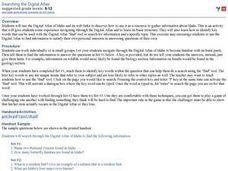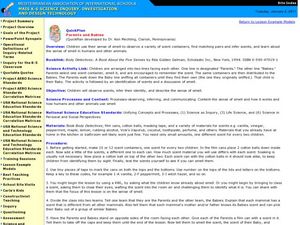Mammal Teacher Resources
Find Mammal lesson plans and worksheets
Showing 2,945 resources
Curated OER
How Sweat Glands Cool Your Body
Students use water and rubbing alcohol to explain how sweat cools mammals' bodies. They write their findings in a journal. After a lecture/demo, students perform a simple experiment that demonstrates this phenomenae.
Curated OER
Shadow Know-How: Marine Animals
In this fill in the blank worksheet, students identify the names of ten marine mammals by analyzing their outlines in shadow pictures.
Curated OER
Shadow Know-How
In this fill in the blank worksheet, students identify the names of ten different marine mammals by analyzing their outlines in shadow
pictures.
Curated OER
Name Match
In this name match worksheet, students match up fourteen North American mammals to their formal names by drawing a line from one to the other.
Curated OER
Color Me
In this color me worksheet, students color and illustrate four common African mammals: Thomson's Gazelle, giraffe and zebra and Patas monkey.
Curated OER
Color Me
In this color me worksheet, students color and illustrate four urban mammals: red fox, white-tailed deer, eastern gray squirrel and eastern cottontail.
Curated OER
Color Me
In this color me worksheet, students color and illustrate four Australian and Tasmanian mammals: red kangaroo, numbat, little red flying-fox and Tasmanian devil.
Curated OER
Connect the Dots
In this connect the dot worksheet, students connect the dots to reveal a flying mammal that uses radar-like echolocation to find its way around in the dark.
Curated OER
Orca United Nations
Middle schoolers study the differences between sets of data and explain how organisms are adapted to their environment. In this marine mammals lesson students analyze data based on set criteria.
Curated OER
Mammal Morphology - Bats, People, and Other
In this physical characteristics worksheet, students compare bats and humans by putting a + sign in the chart for whether or not bats and humans have the same characteristics. Students do this for 17 characteristics and answer 3 questions.
Curated OER
Comparing and Contrasting a Desert Reptile and a Rainforest Mammal
First graders compare and contrast two different type of animals while also making predictions, observations, and asking provocative questioning. In this compare and contrast instructional activity, 1st graders acquire knowledge about...
Texas Instruments
Can You Breathe Like a Pinniped?
Young learners compare the breathing patterns of different animals in this pinniped lesson. They examine the breathing pattern of California sea lions and northern elephant seals. Pupils collect, compare and analyze data concerning...
Curated OER
Steller Sea Lions
In this Steller sea lions worksheet, students read information and do activities on four pages. Students put life cycle events in chronological order.
Curated OER
Plants and Animals
Students find common needs between plants and animals. In this plants and animals instructional activity students compare that both plants and animals need food and water. They also find the differences between plant and animal needs.
Curated OER
Sound for Sight
Students study echolocation and understand how dolphins use it to locate prey, escape predators, and navigate their environment. They view a video, "In the Wild-Dolphins with Robin Williams" and see first hand how dolphins communicate. ...
Curated OER
All About Bats
Second graders research everything they know about bats. They find out anything about bats that was not discovered by the class and to come back and share the new information. They color their own picture of a bat and will write at least...
Curated OER
Life Has A History
In this biology activity, students identify and match various classes of species found today. Then they explain why biodiversity exists today on earth and define evolution. Students also describe who a paleontologist is and what they do.
Curated OER
Discover the Similarities: Marine Mammal Rescue
Students analyze the the similarities of their own daily schedule, processes and procedures and those used at work. They research the career of marine mammal rescue and email questions to a career expert. They construct a display and...
Curated OER
Searching the Digital Atlas
High schoolers become familiar with the tools of a digital atlas. They use a digital atlas of Idaho to located specified information. Students identify national forests, locate butterfly families, find examples of resident fish, and...
Curated OER
Animal Classification
In this animal classification worksheet, students will complete a graphic organizer by writing in the different animal groups: birds, mammals, reptiles, birds, and amphibians.
Curated OER
Parents and Babies
Students examine different scents. In this science lesson, students are divided into being parents or babies and are each given a scent. The "parents" have to identify or infer the scent of their "baby" showing that every mammal has a...
Curated OER
Mammals and Reptiles
Students are read books about the different characteristics of mammals and reptiles. They then draw pictures of mammals, write down the animals' name and staple the pictures together to make a booklet and list their characteristics on...
Curated OER
Who Am I?
Young biologists can see a variety of animals, amphibians, mammals, insects and clearly identify them. They match up the animals' names with the picture. The pictures are clear and colorful! A very nice worksheet for early elementary...
Curated OER
Structures That Reveal Common Ancestry
Float like a butterfly, sting like a bee, check out wing shapes for common ancestry! Beginning biologists compare wings as analogous structures and discover that environment influences evolution of adaptations. A third activity relies on...
Other popular searches
- Ocean Mammals
- Characteristics of Mammals
- Marine Mammals
- Mammals and Fish
- Animals Mammals
- Human/mammal Life Cycle
- Land Mammals
- Mammals (Wildlife)
- Prehistoric Mammals
- Mammal Characteristics
- Mammals Word Search
- Mammals Crossword

























